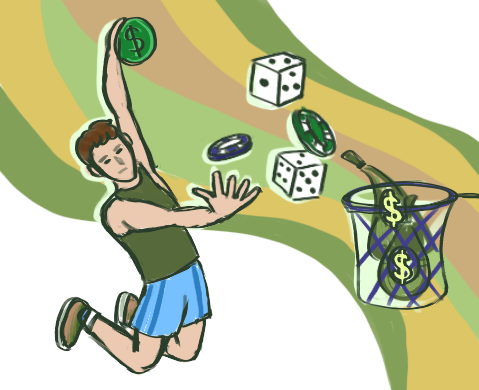Imagine shaking off the rust from two long years spent in the pandemic for your first high school volleyball season. Then picture winning the Central Coast Section title. Next, you return to club training for nationals and notch a national championship a short two months later. This six-month streak, held by varsity boys and Bay-to-Bay volleyball player Edis Mesic (12), relied on the dynamics between club and high school sports.
Upon reaching high school, many student-athletes find themselves faced with a choice: play a club sport, a high school sport, or, like Edis, do both. Private organizations host club sports, and typically provide year-round, national opportunities. High school sports happen during a single season, are directed by each school, and are typically confined to a local league and division. While club and high school sports are each demanding in their own right, both options provide complementary facets to the athletic experience.
A major concern for student-athletes when making this decision is time commitment. Unlike club sports, where training schedules tend to include practice or conditioning a few times a week as well as tournaments on select weekends, high school sports require daily practices, frequent strength training or conditioning and lengthy games multiple times a week. Although demanding, the rigorous schedule can benefit athletes who hope to eventually play at the collegiate level, where such schedules are the norm.
“For me, having school practice two hours every day for six days a week is a pretty big time commitment,” varsity girls basketball player Finley Ho (9) said. “They’re both very time consuming, just in different ways. But I feel like during the school season, I can really practice and get better because I’m seeing the same people every day and practicing for two hours.”
Similarly, in club, many athletes compete with the same team for most of their careers, but high school sports turn over new members every year. Learning to adjust to new teammates and embrace unfamiliar styles of play strengthens an athlete’s overall game and increases their adaptability. Especially as players reach their final years of high school, taking on senior mentorship positions with underclassmen can develop their leadership skills.
“In high school sports, you could have people four years apart on any given team, and they’re all expected to compete at the same level,” Edis said. “I think that’s really great for people who are both younger and even when you’re older, too, taking that leadership role. Especially when you’re younger on teams, it builds a lot of skills you wouldn’t get on a club unless you were playing up.”
High school sports also incorporate mixed skill levels into one team. The same group may host Division I commits and recreational players, depending on the specific circumstances of the high school program.
“My current club, I feel like we’re all around the same level,” Finley said. “Obviously, there’s some people who have different strengths, different weaknesses. In school, there’s a bigger difference between skill levels. Especially leaning towards the juniors and seniors, which makes sense, because they’ve been playing high school basketball for longer.”
This instability also impacts game strategy. Faced with only a few months to fine tune a new team, high school sports coaches may relinquish some of the technique-based training typically found in club sports to tailor their game strategy to a unique high school group. San Jose Express and Harker varsity boys water polo coach Dr. Victor Adler pointed to this give-and-take as a key difference between the two systems.
“The club game schedule is way less frantic than the high school game schedule,” Adler said. “The club season is much longer term. We’re willing to sacrifice a game here and there if we’re doing the right things and preparing the kids for the long term.”
Due to the daily practice that high school sports provide, they amplify one’s club training and strengthen any player’s skills on and off the court. Simultaneously, for many athletes, club programs can provide the best chances at recruiting and the most prestigious athletic experiences that allow the athlete to join targeted teams and compete at the national level.
Despite the challenges of balancing both schedules, those willing to take on both high school and club sports can develop well-rounded athletic and interpersonal skills, like leadership and work ethic. For many, high school-age athletics comprise their final years of formal competition, and serve as a culmination of as much as a decade of dedication.
“For me, seeing these kids again, the kids we’ve had forever, and thinking that, ‘oh my God, these kids have been with us since they were nine years old, and now they are juniors and seniors,” Adler said. “Congratulations to you guys for doing that grind year in and year out. It’s just a huge amount of commitment, and you see how important preparation is, and you see how important consistency is.”




![LALC Vice President of External Affairs Raeanne Li (11) explains the International Phonetic Alphabet to attendees. "We decided to have more fun topics this year instead of just talking about the same things every year so our older members can also [enjoy],” Raeanne said.](https://harkeraquila.com/wp-content/uploads/2025/10/DSC_4627-1200x795.jpg)


















![“[Building nerf blasters] became this outlet of creativity for me that hasn't been matched by anything else. The process [of] making a build complete to your desire is such a painstakingly difficult process, but I've had to learn from [the skills needed from] soldering to proper painting. There's so many different options for everything, if you think about it, it exists. The best part is [that] if it doesn't exist, you can build it yourself," Ishaan Parate said.](https://harkeraquila.com/wp-content/uploads/2022/08/DSC_8149-900x604.jpg)




![“When I came into high school, I was ready to be a follower. But DECA was a game changer for me. It helped me overcome my fear of public speaking, and it's played such a major role in who I've become today. To be able to successfully lead a chapter of 150 students, an officer team and be one of the upperclassmen I once really admired is something I'm [really] proud of,” Anvitha Tummala ('21) said.](https://harkeraquila.com/wp-content/uploads/2021/07/Screen-Shot-2021-07-25-at-9.50.05-AM-900x594.png)







![“I think getting up in the morning and having a sense of purpose [is exciting]. I think without a certain amount of drive, life is kind of obsolete and mundane, and I think having that every single day is what makes each day unique and kind of makes life exciting,” Neymika Jain (12) said.](https://harkeraquila.com/wp-content/uploads/2017/06/Screen-Shot-2017-06-03-at-4.54.16-PM.png)








![“My slogan is ‘slow feet, don’t eat, and I’m hungry.’ You need to run fast to get where you are–you aren't going to get those championships if you aren't fast,” Angel Cervantes (12) said. “I want to do well in school on my tests and in track and win championships for my team. I live by that, [and] I can do that anywhere: in the classroom or on the field.”](https://harkeraquila.com/wp-content/uploads/2018/06/DSC5146-900x601.jpg)
![“[Volleyball has] taught me how to fall correctly, and another thing it taught is that you don’t have to be the best at something to be good at it. If you just hit the ball in a smart way, then it still scores points and you’re good at it. You could be a background player and still make a much bigger impact on the team than you would think,” Anya Gert (’20) said.](https://harkeraquila.com/wp-content/uploads/2020/06/AnnaGert_JinTuan_HoHPhotoEdited-600x900.jpeg)

![“I'm not nearly there yet, but [my confidence has] definitely been getting better since I was pretty shy and timid coming into Harker my freshman year. I know that there's a lot of people that are really confident in what they do, and I really admire them. Everyone's so driven and that has really pushed me to kind of try to find my own place in high school and be more confident,” Alyssa Huang (’20) said.](https://harkeraquila.com/wp-content/uploads/2020/06/AlyssaHuang_EmilyChen_HoHPhoto-900x749.jpeg)












